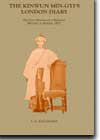| Our Publications | ||
| Books by Title | ||
| Books by Author | ||
| Books by Country | ||
| E-books | ||
| About | ||
| Orchid Press E-books | ||
| Distributed E-books | ||
| Our Bookshop | ||
| About Us | ||
| Browse Shop | ||
| How to Buy | ||
| Contact Us | ||
| WE BUY BOOKS AND LIBRARIES | ||
|
||
Book Reviews

The Kinwun Min-Gyi’s London Diary:
The First Mission of a Burmese Minister to Britain, 1872
byL.E. Bagshawe
2006. 412 pp., 26 b&w ill., 1 table, index, 24.5 x 17.5 cm., hardcover
ISBN-10: 974-524-021-4 $45.00
ISBN-13: 978-974-524-021-6
The Burmese in Victoria’s Court
Mandalays first diplomatic visitors to Europe hit many snags, viewed many wonders, and endured many boring parties
Book review by Michael Smithies
(The Nation)
Sunday 03 June 2007This account of the first diplomatic mission from Burma to Europe, written by the head of mission, is of value because it’s the view from the Burmese side. One wishes we had something like this for Kosa Pan’s 17th-century visit to France.
The background to the mission is given in the translator’s extensive and helpful introduction. Burma, after its second war with Britain in 1852-3, was anxious, under King Mindon, to create a good impression. It sent out feelers to other countries, notably France and Italy, to counterbalance the overpowering British presence in its former southern and coastal regions.
It wanted arms, but these had to be imported via Rangoon, now in British hands, and the colonial power, directed from Calcutta, did not “give proper recognition to the independence of the Burmese kingdom”. Furthermore, the local commissioner, Eden, was hostile to Burma, and did all he could to thwart the mission to Britain.
Complicating the scene was the desire of Western merchants to enter the China trade through Burma and the fact that the Muslim Panthays living in Yunnan were in revolt against Chinese rule, while China was viewed by the Brits as a friendly power.
Eventually the Chinese overran the Panthay sultanate and the proposed railway to Yunnan didn’t get far.
The diplomatic entourage’s journey by steamer coursed through the recently opened Suez Canal to Italy, where King Victor Emmanuel II, to the astonishment of the Burmese, “goes about the streets in a way no different from anybody else”.
They took the train to Paris—then recovering from the Franco-Prussian War—and crossed the Channel to Dover.
After much sightseeing and banqueting in and around London, they set out for Birmingham, Manchester, Liverpool, Bangor, Bradford, Sheffield, Newcastle, Edinburgh, Glasgow, Leeds, Dublin and Killarney.
How bored they must have been, visiting pin factories, cotton mills and steel furnaces, and enduring the endlessly repetitive speeches of municipal worthies! But they were model guests, politely enduring the receptions, and were fascinated by the shows at the Crystal Palace.
They had an audience with Queen Victoria, presenting her with a letter from King Mindon and a case containing a ruby girdle and a ruby bracelet.
Their hosts were perhaps not always attentive to details. Included on the trip to Glasgow was a visit to a brewery, though none of the Burmese drank alcohol. The Kinwun Min-gyi suggested at one stage that the epidemic of gout afflicting British elder statesmen was due to “their custom of regularly chinking so much liquor”.
They saw snow for the first time, but were able to complain of the heat too. They made no comments about the food, but did ask about arcane practices like leaving one’s calling card in person.
They returned to Paris in November, but President Thiers proved elusive and a proposed treaty with the French ran into difficulties after returning to London to make their farewells, they picked up in Paris protocol copies of the treaty and headed for Rome to meet Pope Pius IX.
In Ceylon on the voyage home they attended the pilgrimage to the Temple of the Tooth in Kandy and acquired a copy of the relic, which was shown all the reverence due the real thing once back in Burma.
In Calcutta they were received twice by the viceroy, and then it was back to Rangoon—and reality: a hostile reception, complications with customs, Commissioner Eden being as difficult as possible, no 19-gun salute, and no acknowledgement of their status as envoys of the independent Lord of the Sunrise.
They carried on in high dudgeon, arriving in Mandalay on May 2, 1873. Throughout their journey they had been accompanied and assisted by an efficient and wealthy trader named Jones, who had the misfortune to die the day after their return.
This is not the first time this work has been published—Burmese editions appeared in 1908 and 1953-4—or translated. But this is the first stand-apart edition in English. Transcriptions from Burmese into English of personal and place names often proved difficult, if not impossible.
On the whole the translation reads well, but this reviewer would have preferred a more complete rendition of Burmese terms, and a glossary would have been helpful.
There are generous footnotes, but they sometimes demand a good knowledge of Burmese, and they are often astonishingly informal (“That’s what my dictionary says for zat-bu-pani-bin” one insists).
Though this edition has some drawbacks (not least the lengthy paragraphs), it is on the whole well presented and has been worth the long wait since it was first proposed. The text is enlivened with contemporary press notices and etchings. It is beautifully bound, and a delectable work to dip into.
[Read a review from the Journal of the Siam Society] [Read a review from Planet Myanmar] [More Orchid Press Reviews]
PO Box 70, Trinity TB, NL, A0C 2S0, Canada
Telephone: +1 709-330-4703